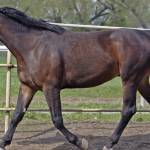Gastrointestinal Tract Basics: The Horse’s Hindgut

The horse is a hindgut fermenter, meaning that the large intestine is the site of fermentation of ingested fiber. This is in contrast to ruminants, such as cattle, goats, and sheep, that are foregut fermenters with a rumen and multicompartment stomach. Being a hindgut fermenter is a huge advantage to horses because it essentially gives them a second chance to process energy from feed that has already passed through the small intestine. Since the bacterial and protozoal flora of the hindgut are geared for fiber fermentation, the large intestine is susceptible to upset if it receives large amounts of undigested sugars.
The large intestine begins with the cecum. It is a large blind-ended sac that takes up most of the right side of the horse’s abdominal cavity. Cecal impactions with feed material are fairly common in post-foaling mares and horses that are hospitalized and treated with nonsteroidal anti-inflammatory drugs (phenylbutazone or flunixin meglumine). Rupture of the cecum can sometimes occur and is often a fatal event. It is believed that cecal impactions occur with some unknown disruption of normal gut motility.
The large colon of the horse lies on the bottom and somewhat to the left in the abdominal cavity. The large colon is divided respectively into left and right and dorsal (upper) and ventral (lower) colons. There are three flexures, or U-shaped bends, in the large colon at the sternum, pelvis, and diaphragm. The convoluted course of the large intestine and its relative lack of any anchoring ligaments make it susceptible to displacements and twists. Impactions can occur at the flexure sites where the diameter of the colon narrows. Right dorsal colitis is an ulcerative condition that has been associated with administration of nonsteroidal anti-inflammatory drugs, and it usually leads to low blood protein concentration and intermittent colic.
The small colon is the final part of the large intestine, and it is where fecal balls are produced. Impactions of the small colon sometimes occur. Horses that are fractious or strain against the examiner during rectal palpations or ultrasound examinations can tear the small colon, though this is rare.
Examination of the large intestine without exploratory surgery can be difficult because of its sheer size and inaccessibility. The large colon normally contains gas that prevents a complete ultrasound examination, and most machines cannot penetrate deep enough to image the entire colon. Rectal palpation remains an excellent diagnostic tool for an experienced veterinarian, but only about one-third of the abdominal cavity nearest the rectum can be palpated.








